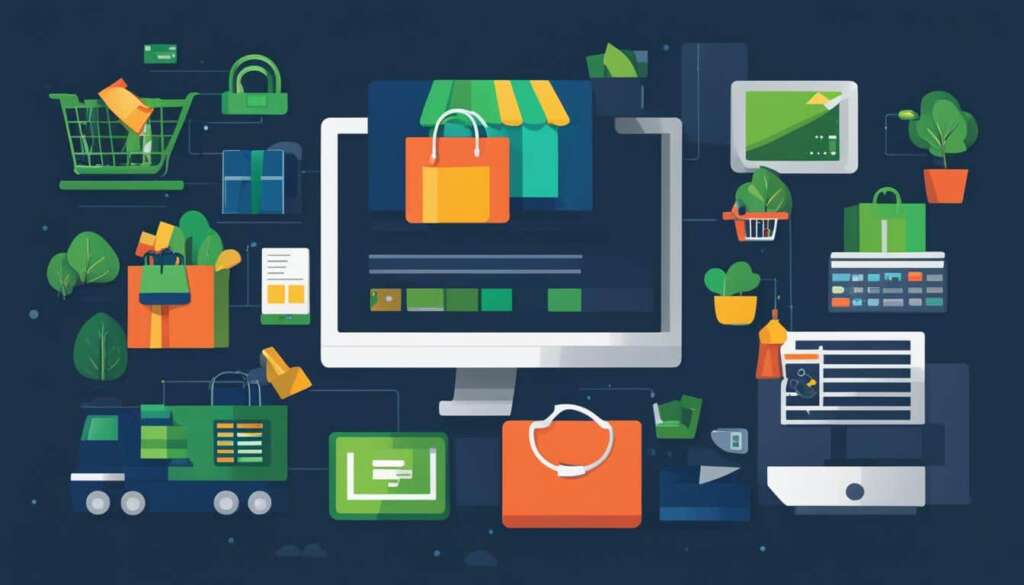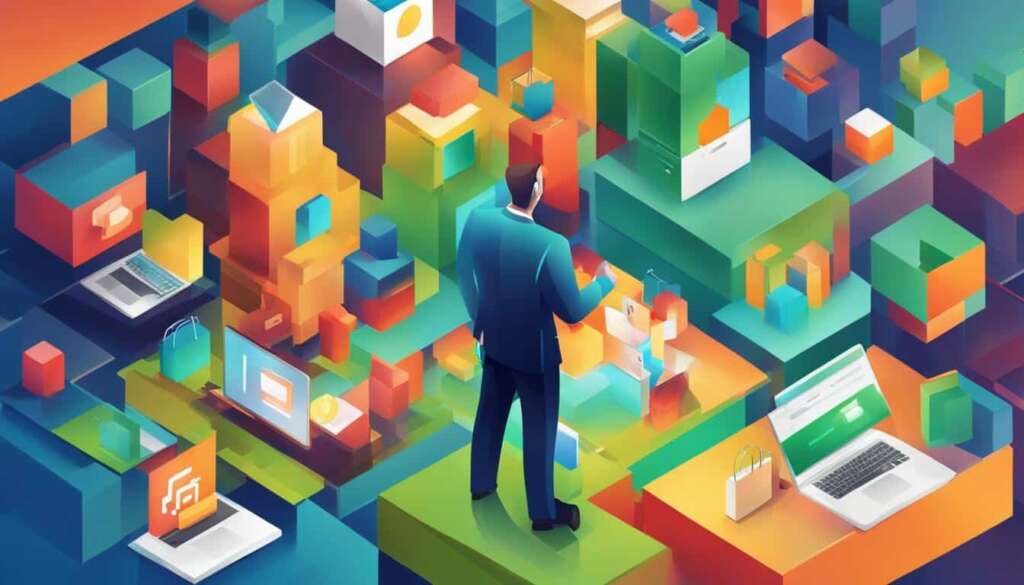Table of Contents
Welcome to our comprehensive guide on e-commerce models and their significance in driving business growth. In today’s digital age, having a strong e-commerce business strategy is crucial for companies to thrive in the competitive market. By understanding the different e-commerce models available, businesses can leverage their unique advantages and position themselves for maximum potential growth.
E-commerce, short for electronic commerce, refers to the buying and selling of goods or services through the internet. With the convenience and accessibility it offers, e-commerce has revolutionized the way businesses operate and interact with customers.
There are four general categories of e-commerce models: B2C (Business-to-consumer), B2B (Business-to-business), B2B2C (Business-to-business-to-consumer), and B2G (Business-to-government). Each model serves a unique purpose and caters to specific target audiences.
E-Commerce Business Models: Business-to-Consumer (B2C)
In the world of e-commerce, one of the most widely recognized business models is the Business-to-Consumer (B2C) model. This model revolves around companies selling products or services directly to end-users, catering to the needs and preferences of individual consumers.
Unlike the Business-to-Business (B2B) model, which focuses on transactions between businesses, B2C businesses have a shorter sales cycle and typically deal with lower average order values. While B2B transactions often involve high-value contracts and recurring purchases, B2C businesses rely on individual customers purchasing products or services at a lower price point.
To successfully market to customers and drive sales, B2C businesses have leveraged various technological advancements. For instance, they utilize e-commerce storefronts to provide a seamless online shopping experience. Furthermore, they invest in targeted marketing strategies, such as mobile apps, native advertising, and remarketing, to directly reach their customer base and enhance their brand presence.
“By embracing these innovations, B2C businesses have not only streamlined the shopping process but have also made it more convenient for customers to browse, purchase, and receive products or services,” explains Sarah Johnson, e-commerce expert.
Well-known examples of B2C businesses include Amazon, one of the world’s largest online retailers offering a wide range of products, and fashion brands that sell directly to consumers through their e-commerce websites. Entertainment streaming platforms like Netflix and Spotify also fall under the B2C model, providing on-demand services to individuals.
To illustrate the differences between B2C and other e-commerce models, let’s dive into a table comparing key aspects:
| B2C | B2B | B2B2C | B2G | |
|---|---|---|---|---|
| Sales Cycle | Short | Long | Varies | Varies |
| Average Order Value | Lower | Higher | Varies | Varies |
| Recurring Orders | Fewer | More | Varies | Varies |
| Examples | Amazon, fashion brands, entertainment streaming platforms | Companies selling products or services to other businesses | Businesses aligning with another organization to sell to end customers | Companies providing products or services to government entities |
As seen in the table, the B2C model stands out with its shorter sales cycle, lower average order value, and fewer recurring orders compared to other e-commerce models. By understanding these nuances, businesses can tailor their strategies and capitalize on the opportunities presented by the B2C business model to drive growth.
E-Commerce Business Models: Business-to-Business (B2B)
The B2B business model is essential for companies that sell products or services to other businesses. Unlike the B2C model, which focuses on selling directly to end-users, B2B transactions involve catering to the unique needs and demands of fellow businesses.
One of the key distinctions between B2B and B2C is the longer sales cycle in the B2B sector. Since businesses typically have more complex procurement processes, decision-making can take longer. However, this longer sales cycle is often accompanied by higher-order value and more recurring purchases, providing businesses with a stable revenue stream.
In recent years, B2B businesses have begun leveraging e-commerce storefronts to streamline their operations and reach a broader audience. By transitioning from traditional catalogs and order sheets to online platforms, B2B companies can provide customers with a more convenient and efficient ordering experience.
This shift to the online space is crucial for B2B businesses, especially as younger generations enter the business world. These digital natives are accustomed to conducting transactions online and expect the same level of convenience and accessibility when interacting with B2B companies.
B2B businesses are also focusing on targeting niche markets to differentiate themselves and provide specialized solutions to their customers. By catering to specific industries or sectors, B2B companies can position themselves as experts and offer tailored products and services that meet the unique needs of their target audience.
As the online B2B selling space continues to evolve, B2B companies must adapt and embrace digital transformation to stay competitive. By leveraging technology and catering to niche markets, B2B businesses can unlock new growth opportunities and establish themselves as leaders in the online B2B ecosystem.

Through the B2B business model, companies can capitalize on longer sales cycles, target niche markets, and thrive in the online space. By understanding the unique dynamics of B2B transactions, businesses can position themselves for success and drive sustainable growth.
E-Commerce Business Models: Business-to-Business-to-Consumer (B2B2C)
The B2B2C business model is an effective strategy for companies looking to reach end customers by partnering with another organization. In this model, the company sells its products or services in collaboration with a partner to the end customer.
What sets B2B2C apart from other models is that the end customer is aware that they are purchasing from the original company and not a white-labeled product. This transparency builds trust and credibility, ensuring a direct relationship between the company and the end customer.
B2B2C models often involve commission-based partnerships, offering mutual benefits to both parties. By leveraging the partner’s existing customer base and distribution network, businesses can quickly acquire new customers and expand their market reach.
“The B2B2C model allows us to tap into new markets and effectively engage with end customers who align with our target audience. Collaborating with a trusted partner enables us to offer a comprehensive solution while maintaining our brand integrity,” says Sarah Johnson, CEO of XYZ Corporation.
The Advantages of the B2B2C Business Model
- Access to a wider customer base: Partnering with another organization enables businesses to reach a broader audience and target new markets.
- Increased brand visibility: By collaborating with a trusted partner, companies can enhance their brand visibility and credibility.
- Diversified revenue streams: With the B2B2C model, businesses can explore additional revenue streams by tapping into partner networks and reaching end customers directly.
- Efficient distribution channels: Leveraging the partner’s distribution network allows for streamlined delivery and increased customer satisfaction.
Success Stories: B2B2C in Action
| Company | Collaboration Partner | Success Story |
|---|---|---|
| XYZ Corporation | ABC Retail | XYZ Corporation partnered with ABC Retail to offer its cutting-edge technology products directly to consumers. The collaboration resulted in a significant increase in sales and brand recognition. |
| 123 Fashion | FashionX | 123 Fashion partnered with FashionX, a popular online fashion platform, to reach a wider audience and expand its market presence. The collaboration allowed 123 Fashion to showcase its latest trends and increase customer engagement. |
Partnering with the right organization can unlock new opportunities for businesses to connect with end customers and achieve sustainable growth. The B2B2C model offers a win-win situation, allowing companies to leverage their expertise while tapping into partner networks to reach a wider audience.
E-Commerce Business Models: Business-to-Government (B2G)
When it comes to e-commerce business models, the Business-to-Government (B2G) model plays a significant role in the marketplace. In this model, businesses sell and market their products directly to government entities or public administrations. The primary revenue stream for B2G businesses is through successful bidding on government contracts by submitting well-crafted proposals.
However, B2G businesses face unique challenges due to the bureaucratic and slower business process involved in dealing with government entities. While this may limit revenue streams, it also provides a sense of security as government contracts often offer long-term commitments. B2G enterprises need to navigate through complex regulations and bureaucratic processes to secure contracts and maintain a competitive edge.
Examples of B2G businesses include companies that provide specialized services or products to government agencies at various levels. These businesses understand the importance of catering to the specific needs and requirements of government entities, ensuring compliance with rules and regulations. By carefully bidding on projects and maneuvering through the bureaucratic landscape, B2G enterprises can establish themselves as trusted partners for government contracts.
FAQ
What are the different categories of e-commerce models?
The four general categories of e-commerce models are B2C (Business-to-consumer), B2B (Business-to-business), B2B2C (Business-to-business-to-consumer), and B2G (Business-to-government).
What is the B2C business model?
In the B2C business model, companies sell products or services directly to end-users. This model has a shorter sales cycle and lower average order value compared to B2B businesses.
What is the B2B business model?
The B2B business model involves selling products or services to other businesses. B2B transactions have a longer sales cycle but higher-order value and recurring purchases.
What is the B2B2C business model?
The B2B2C business model is when a company sells products or services in partnership with another organization to an end customer. This model often involves commission-based partnerships and helps businesses acquire new customers quickly.
What is the B2G business model?
The B2G business model is where a business sells and markets its products to government entities or public administrations. This model relies on successful bidding of government contracts and faces a more bureaucratic and slower business process.













